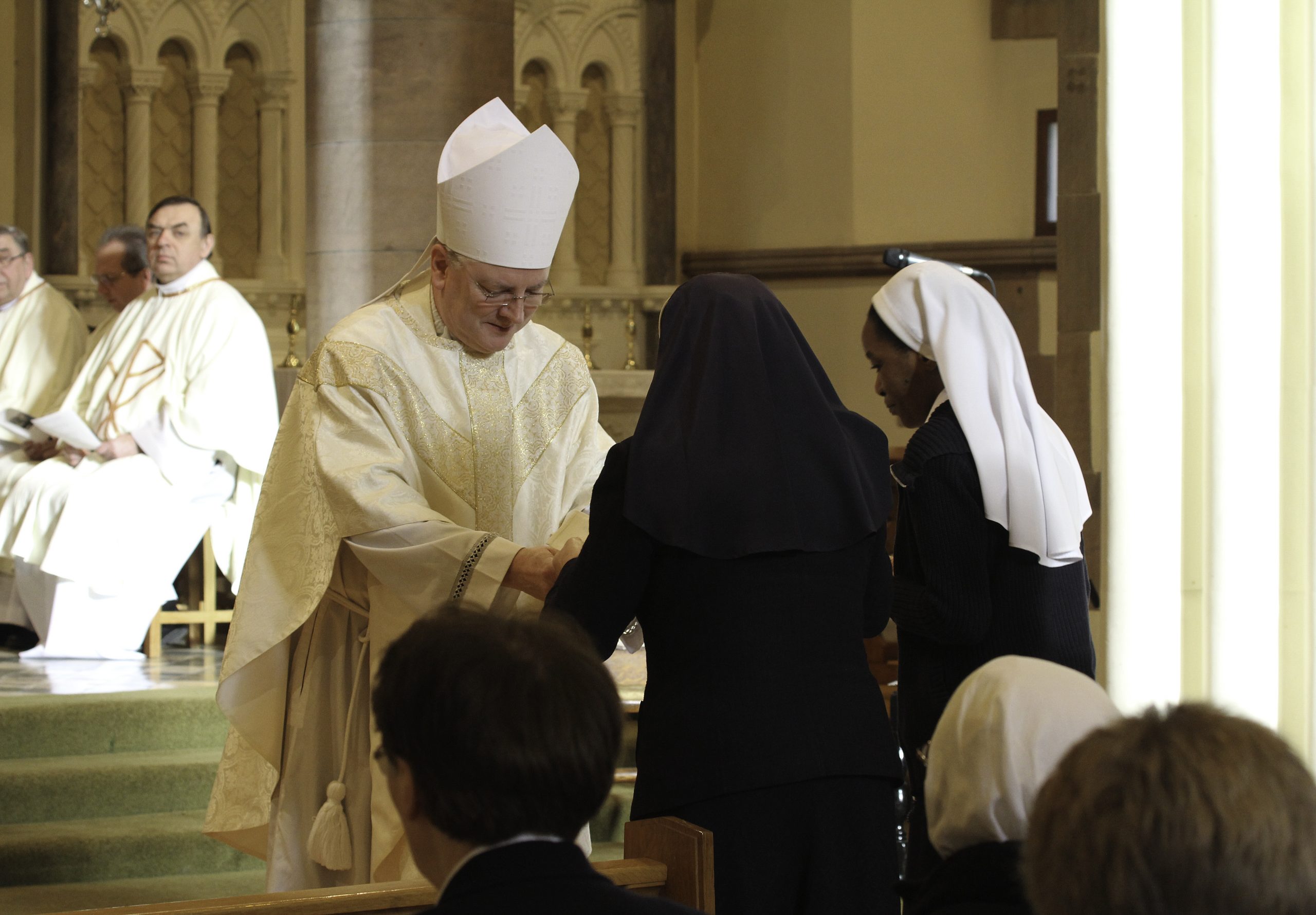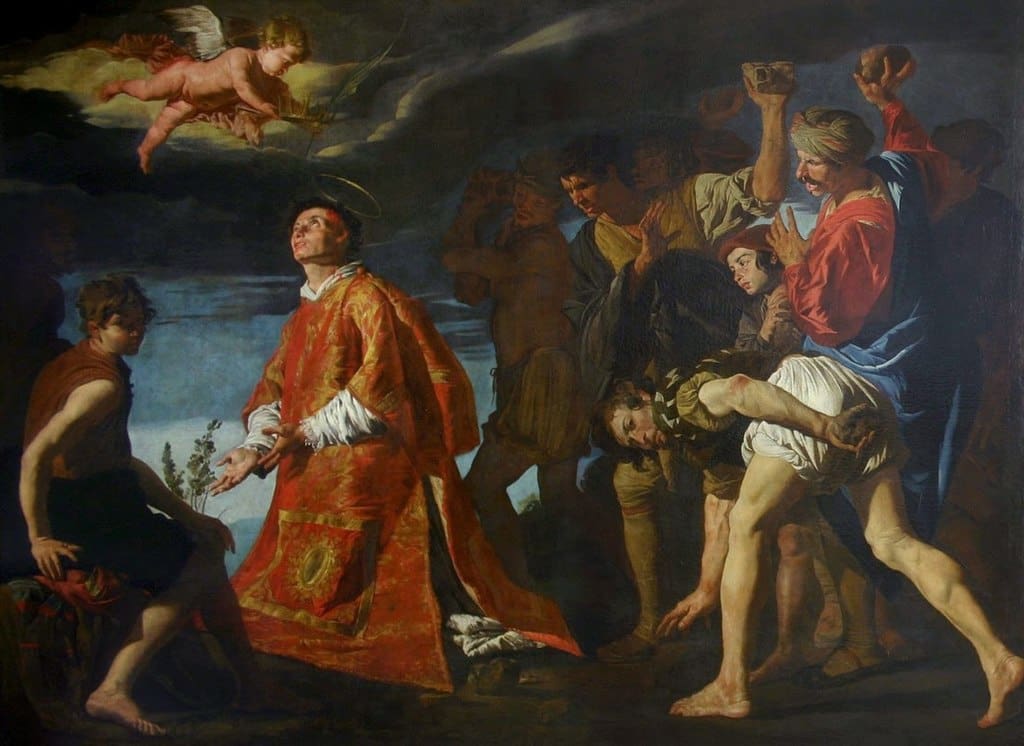
This post continues the examination of the various ways in which the traditional practice of the Roman Rite informs the celebration of Mass according to the Novus Ordo. In the last entry, we saw how “traditional practices of the Roman Rite,” mentioned in no. 42 of the General Instruction of the Roman Missal (GIRM), added context and informed some unanswered questions surrounding the preparation of the gifts and the altar.
If the faithful are to present the gifts of bread and wine (GIRM, 73, 140; Order for Mass, 22), the deacon, who has been at the altar preparing it and the gifts, may remain at the right side of the altar until such faithful are in place, or he may return to his seat by the priest to wait for them to be ready. When the faithful are ready to present the gifts of bread, wine, and even monetary contributions from the collection plates, the celebrant and the deacon, or even the deacon alone, joined by one or more servers “go to the appropriate place” designated to receive the gifts (GIRM, 73). That place may be at the entrance to the sanctuary, at the chair (as is often the case in the Mass celebrated by a bishop), or at the altar itself. A master of ceremonies or a server may accompany the faithful from their places and back, generally walking to their left.
The gifts are received individually by the celebrant and handed to the deacon who stands on the celebrant’s right. The deacon in turn may hand the gifts to waiting servers. The celebrant may acknowledge those who presented the gifts with a bow of the head. Those who presented gifts would bow to the celebrant before departing. When all the gifts have been presented, the celebrant should have nothing in his hands. If standing before the altar and facing the people, the celebrant turns to his right with hands joined and makes his way to the altar, bowing to the altar upon arriving there (See Peter Elliot, Ceremonies of the Modern Roman Rite, Ignatius Press, 102). All who assisted the celebrant likewise bow to the altar if they happen to pass in front of it.
At the altar, the deacon, who is standing to the celebrant’s right, places the paten with the host or hosts in the priest’s hands. The priest holds the paten in both hands over the corporal slightly elevated, and says the prayers. He then places the paten at the center of the front portion of the corporal (Elliott, Ceremonies, p. 102).
At the right side of the altar, the deacon begins to prepare the chalice. First, holding the chalice on the altar itself by its node in his left hand (and not away from the altar or above the altar), he holds the fingers of his right hand together and lowers the purificator resting on top of the chalice into the bottom of the cup and wipes the interior of the cup of the chalice. Then he drapes the purificator over the thumb of his left hand at the node of the chalice so that the folded purificator falls over his thumb. With his right hand, he takes the cruet of wine presented him by the server (who holds it in his right hand with the handle facing out) and pours a portion of the wine into the chalice. The deacon wipes the mouth of the cruet on the purificator and returns it to the server. In the meantime, the server has placed the cruet of water in his right hand from this left hand. The server receives the cruet of wine in his left hand and offers the cruet of water, with handle facing out, with his right hand. The deacon does not make the sign of the cross over the cruet of water (neither does the priest, if he prepares the chalice in the absence of a deacon). The deacon takes the cruet of water and adds a little water (a few drops) to the wine, wipes the mouth of the cruet on the purificator and returns the cruet to the server. The server bows to the deacon and returns to the credence table with the two cruets. At no point is either cruet placed on the altar. Each cruet is held either by the server or the deacon (or celebrant) at all times.
The deacon then takes the interior of the folded purificator and wraps it around the index finger of his right hand at its center, holding it there with the thumb of his right hand, and wipes the drops of wine or water from the interior of the cup of the chalice. He refolds the purificator and places it next to the corporal along its length. Taking the chalice in both hands, with the right hand at the node and the left hand at the base, the deacon hands it to the priest. The celebrant raises it slightly, with his right hand at the node and his left hand at its base, with the base of the chalice a hand’s breadth above the corporal. The celebrant says the prayer regarding the wine. He then places the chalice down on the corporal, at the center of the back portion of the corporal. The deacon covers it with the pall using his right hand, his left hand resting on his chest. Meanwhile the celebrant places his left hand on the base of the chalice to prevent any accident. His right hand rests on the altar outside the corporal. (See Elliott, Ceremonies,103; A. Mutel and P. Freeman, Cérémonial de la Sainte Messe, Artège,112-114.)
If there is no deacon, the celebrant prepares the chalice in the same way, standing at the right hand side of the altar. Having completed the preparation of the chalice, he may place it closer to the corporal with his left hand. Holding the purificator with his joined hands, he returns to the center of the altar, puts the purificator down, the folded edge closest to him, with its length along the corporal. Then, still standing at the center, he reaches for the chalice at its node with his right hand, and holds it over the corporal with the left hand at its base as indicated above. (See Mutel and Freeman, Cérémonial, 115)
The celebrant steps back slightly and bows deeply with hands joined to say the prayer With humble spirit (Order for Mass, 26). Traditionally, the celebrant rests the index and third fingers of his joined hands on the edge of the altar, with the remaining fingers of his joined hands touching the edge of the altar (See Mutel and Freeman, Cérémonial, 114). Rising, he turns to his right and goes to the right side of the altar with hands joined. There a server holds a basin in his left and and cruet or pitcher in his right hand with which to wash the celebrant’s hands. A towel or finger towel is draped on the server’s left arm. The deacon may take the towel from the server, open it, and hold it in both hands at its two corners in order to present it to the priest. The priest may take it from him, wipe his hands and return it to the deacon, who then folds it and places it on the left arm of the server. The server bows to the celebrant and returns to the credence table. The deacon may now stand at the priest’s left in order to turn the pages of the missal, or he may remain at his right for the entire Eucharistic Prayer. In this case, a master of ceremonies or the priest himself will turn the pages of the missal.
The celebrant, with hands joined, turns to his left and returns to the center of the altar. There he extends and joins his hands as he says, Pray brethren (brothers and sisters), while looking at the people (If he is facing liturgical east, he turns on his right to say, Pray brethren. The deacon standing at his right does not turn around but remains facing the altar. After the people have answered, the priest turns again to his right, completing the circle to face the altar.) Unless the deacon or a master of ceremonies does so, the celebrant then turns the pages of the missal to the prayer over the gifts with his left hand, his right hand resting on the altar outside the corporal. He says the prayer of the gifts with hands outstretched. He joins his hands at the concluding formula, “through Christ our Lord.”
Then begins the Eucharistic Prayer, the heart of the Liturgy of the Eucharist. The next post will treat the various postures and gestures of the celebrant, as well as those of the various others ministers during this portion of Mass. In the fullest form of the celebration of the Eucharistic Prayer, a complex series of movements and gestures accompanies the words of this great prayer of praise and thanksgiving.
This is the tenth part of an ongoing series for Adoremus by Monsignor Caron on “Liturgical Traditions,” one that situates the Novus Ordo rites amidst the received liturgical observances, thereby helping us to understand today’s rites in their proper “hermeneutic of reform.” Read the previous parts of the “Liturgical Traditions” series by clicking here.



